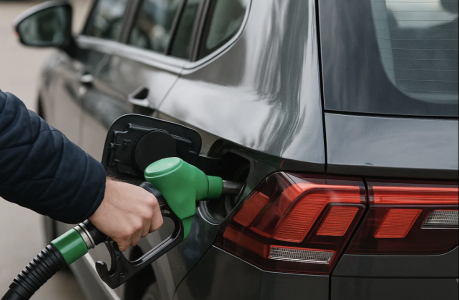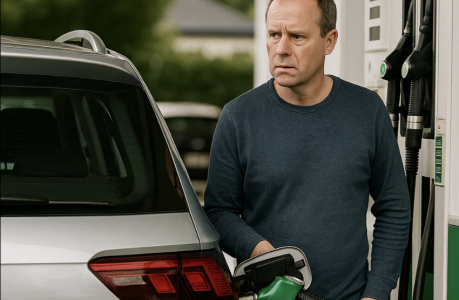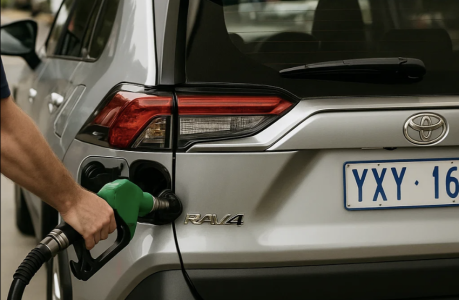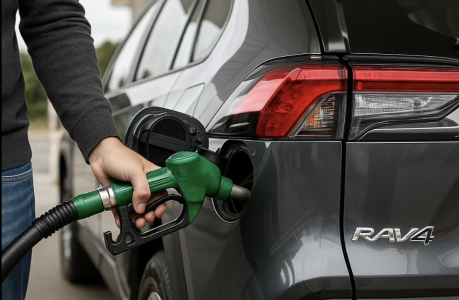Cars Behaving Badly: Why Your “Fuel-Efficient” Car Might Be Guzzling More Than Promised
- Replies 0
It’s a familiar scene: pulling up to the servo more often than expected because your “fuel-efficient” car isn’t as frugal as promised.
For many Australians, those official economy numbers on the sticker have always felt a bit optimistic. Now new testing confirms that gut feeling – popular cars are indeed thirstier than advertised, and the difference can hit your wallet.
A major new real-world study by Australia’s peak motoring body has revealed that many best-selling cars and SUVs are using significantly more petrol in everyday driving than their manufacturers claim. The Australian Automobile Association (AAA) tested 30 popular models on roads around Geelong, Victoria – and 25 of those vehicles consumed more fuel than advertised. In other words, if you bought a car based on its impressive fuel economy label, there’s a good chance you’re getting a less impressive surprise at the bowser.
How much more fuel are we talking about? Some cars only missed the mark by a whisker, but others were way off the charts. One of the biggest offenders was the Hyundai Kona Hybrid, a small SUV touted for its efficiency – it drank 33% more fuel on the road than it did in the lab tests (5.2 litres per 100km in real life versus the advertised 3.9 L/100km).
To put that in perspective, that’s like expecting to drive from Sydney to Newcastle on a tank but running dry somewhere around the Central Coast. And the Kona wasn’t alone: a pint-sized Kia Stonic used 26% more fuel than its sticker claim, and even the humble Hyundai i30 Hybrid hatchback burned 17% more than advertised.
Family SUVs aren’t off the hook either – the Toyota Fortuner, a large diesel 4WD, chugged 16% above its official figure. It seems no category is immune from a bit of creative optimism in the fuel economy department.
These findings aren’t just one-off anomalies; they reflect a wider trend. Since August 2023, the AAA’s ongoing real-world testing program has evaluated 114 different cars, utes, and vans, finding that more than three-quarters of them (77%) used more fuel on the road than in the lab.
In the latest batch alone, 11 of the 30 vehicles tested guzzled at least 10% more fuel in real conditions than their official rating. So if you’ve felt that your car’s fuel gauge drops faster than it should, you’re probably right – and you’re far from the only one. As the AAA’s managing director Michael Bradley bluntly summed it up, “Some vehicles perform as advertised, but most do not.”
Think of it like a treadmill test for cars: a new vehicle is put on a dynamometer (basically car treadmills) and driven through a preset routine of stops, starts, and speeds. The lab is climate-controlled, the car carries no extra payload, the road is perfectly flat (indeed, there’s no road at all), and the “driver” is a robot following an exact script. Unsurprisingly, the lab results often look rosier than your real commute through Sydney traffic or up the hilly highways of regional Australia.
Regulators have known about this discrepancy for years and have tried to fix it. Europe, for example, introduced a more realistic test cycle known as the WLTP (Worldwide Harmonised Light Vehicle Test Procedure) a few years back, replacing an older, even more optimistic test. Australia’s current fuel economy labels are based on these updated procedures.
WLTP is better than the old tests, but it’s not foolproof. Even with this “worldwide harmonised” test – which was designed with industry input to be closer to real driving – there’s still a gap between the official figures and the on-road reality. As one CarExpert analysis notes, these results show that despite improved testing methods, many cars still fall short once they’re off the test rig and onto actual roads.
Why? One reason is that car makers know exactly how to optimize for the test conditions. It’s a bit like students studying just the questions that will be on the exam – the engine control software and transmission can be tuned to excel in the specific cycle the lab uses. Michael Bradley from the AAA put it this way: “It’s becoming clear that many cars are built to look good in tests, not to deliver those savings in reality.”
In everyday driving, where we accelerate harder, carry passengers, encounter hills, and blast the air-con on a 35°C summer day, the car behaves differently – and usually burns more fuel. The AAA suspects manufacturers are “optimising their vehicles’ performance for lab testing” too much, to the point that it “overstates their improvements in fuel use and environmental performance” in the real world. In plain English, they’re gaming the system – within legal bounds – to make those showroom numbers look enticing.
Now, to be fair to the car companies, everyone has to take the same test. The government mandates the procedure, and the results are meant to provide a consistent way to compare one car versus another. The fine print on the fuel sticker even admits “your actual fuel consumption may vary”. And boy, does it vary! Some of that variation is on us – heavy-footed driving or lots of stop-start city trips will use more petrol than a gentle highway cruise.
But what the AAA’s program exposes is that some models are inherently worse in real life than others, even if they had similar lab results. In the AAA’s 2017 pilot tests, nearly all of 30 cars tested used more fuel on the road than advertised, but the gap ranged from just a few percent in some cars to a whopping 59% worse in the worst case. As the AAA noted, “when people go to buy a new car, it can be almost impossible to know which is actually the most fuel efficient — or which has just been engineered to do well in a lab test.”
None of this is to suggest carmakers are pulling a Volkswagen-style Dieselgate scam – there’s no evidence of illegal defeat devices in these tests, just legal loopholes and optimal conditions. But from a consumer standpoint, the result can feel a bit like a bait-and-switch. You buy a car expecting stellar mileage, only to find it slurps juice like an older model.
Driving from Sydney to Canberra (approximately 286 km) would cost about $62 in fuel instead of $49 at $2 per litre. That’s an extra $13 for one road trip. Over a year of driving, you could be spending hundreds of dollars more on petrol than you budgeted. For pensioners or anyone watching their pennies, that’s not small change – it’s grocery money or a couple of nice dinners out, gone up in exhaust fumes.
There’s also a broader environmental and health angle to this story. Cars that burn more fuel than advertised are also emitting more carbon dioxide (bad for the climate) and often more pollutants (bad for us). The AAA’s tests found six models that passed the pollution tests in the lab but then exceeded legal limits for noxious emissions on the road. This rogue’s gallery included Toyota’s Fortuner SUV, Suzuki’s Vitara, the Ford Ranger ute, Toyota HiAce vans, and a BMW X1.
Imagine that – you think you’re driving a modern, clean vehicle, yet it might be belching out more nasties in real traffic than it’s supposed to. It’s a bit like a diet food that secretly packs more calories: not good for the waistline, or in this case, the lungs. The fact that even our top-selling Ford Ranger was among those flagged for high NOx emissions (though its fuel use was fairly close to claimed) shows this isn’t just an issue with obscure models. It’s mainstream. This puts pressure on carmakers to not just talk the talk on eco-friendly improvements, but to walk the walk when their vehicles hit Aussie streets.
In the interest of fairness (this is an editorial, after all, and we like to consider both sides), it’s worth noting that a few cars actually outperformed their official fuel figures. Yes, they are rare, but they exist – little unicorns of honesty in an industry prone to hyperbole. The AAA’s program turned up a handful of models that used less fuel than advertised in real driving. For instance, Ford’s Transit Custom van delivered about 9% better fuel economy than its lab rating. (Tradies everywhere, rejoice – that’s one work van that truly goes the extra mile on a tank.)
A Lexus NX350h hybrid SUV beat its official figure by roughly 7%, and a Mercedes-Benz GLC petrol SUV managed about 3% better than claimed. These cases are the exception, not the rule – but they prove that getting it right is possible. If some cars can do it, why not the rest? It’s a question worth asking next time a salesperson boasts to you about fuel numbers. Perhaps we should be congratulating Ford and Lexus for under-promising and over-delivering, while side-eyeing the others for doing the opposite.
Under this policy, car brands will be measured on the average CO2 emissions of the vehicles they sell, and those who exceed the targets will cop financial penalties. In short, if a company’s fleet guzzles too much and pollutes too much, it’ll pay for the privilege. On the flip side, brands that stay under the limits (by selling cleaner, more efficient models) can earn credits – effectively getting rewarded for doing the right thing. This kind of standard is common in places like Europe and the US, and it’s finally coming to Australia to address our reputation for being a dump for gas-guzzlers.
Not everyone in the auto industry is happy about the new rules – some executives have complained the targets are too tough or rushed (typical, isn’t it?). In fact, the policy sparked a bit of drama: electric vehicle makers like Tesla and Polestar quit the industry’s peak lobby group in protest, arguing that the main auto industry body was resisting stricter standards. Those companies wanted even stronger action on emissions.
So on one side, you’ve got parts of the industry saying “Whoa, slow down with these regulations,” and on the other, you’ve got the EV folks saying “Bring it on, and make it tighter!” From a consumer’s viewpoint – especially an older one who’s seen lots of corporate push-and-pull – it’s an interesting tug-of-war. But whichever side you’re on, the end goal is cars that truly deliver on their promises: both in saving us money and in cutting pollution.
And speaking of promises, it’s not just petrol and diesel cars under the microscope. The AAA has signaled that electric vehicles (EVs) are next in line for real-world scrutiny. A big concern holding back some buyers (perhaps including some of you reading this) is “range anxiety” – the fear that an EV won’t actually travel as far on a charge as the glossy brochure claims.
Starting soon, the testing program will measure EVs’ actual driving range in Aussie conditions and compare it to the official figures. If you’re curious whether that new Tesla or Nissan Leaf will go the distance from Brisbane to Toowoomba without needing a recharge, this data will help answer that. It’s all about giving us real, no-nonsense info. After all, whether it’s litres of unleaded or kilowatt-hours of battery, no one likes unpleasant surprises after they’ve paid good money for a vehicle.
Source: Donut / Youtube.
Read more: You paid fuel tax for decades—here’s what they’re taxing next

So, what do you think? Next time you’re car-shopping or eyeing those efficiency claims, will you trust the sticker, or trust your gut and independent tests? Should car manufacturers be held to a stricter “truth-in-advertising” standard for fuel economy, or is this just an inevitable quirk of laboratory testing versus real life? It’s a question worth pondering as we turn the key and hit the road.
For many Australians, those official economy numbers on the sticker have always felt a bit optimistic. Now new testing confirms that gut feeling – popular cars are indeed thirstier than advertised, and the difference can hit your wallet.
A major new real-world study by Australia’s peak motoring body has revealed that many best-selling cars and SUVs are using significantly more petrol in everyday driving than their manufacturers claim. The Australian Automobile Association (AAA) tested 30 popular models on roads around Geelong, Victoria – and 25 of those vehicles consumed more fuel than advertised. In other words, if you bought a car based on its impressive fuel economy label, there’s a good chance you’re getting a less impressive surprise at the bowser.
How much more fuel are we talking about? Some cars only missed the mark by a whisker, but others were way off the charts. One of the biggest offenders was the Hyundai Kona Hybrid, a small SUV touted for its efficiency – it drank 33% more fuel on the road than it did in the lab tests (5.2 litres per 100km in real life versus the advertised 3.9 L/100km).
To put that in perspective, that’s like expecting to drive from Sydney to Newcastle on a tank but running dry somewhere around the Central Coast. And the Kona wasn’t alone: a pint-sized Kia Stonic used 26% more fuel than its sticker claim, and even the humble Hyundai i30 Hybrid hatchback burned 17% more than advertised.
Family SUVs aren’t off the hook either – the Toyota Fortuner, a large diesel 4WD, chugged 16% above its official figure. It seems no category is immune from a bit of creative optimism in the fuel economy department.
These findings aren’t just one-off anomalies; they reflect a wider trend. Since August 2023, the AAA’s ongoing real-world testing program has evaluated 114 different cars, utes, and vans, finding that more than three-quarters of them (77%) used more fuel on the road than in the lab.
In the latest batch alone, 11 of the 30 vehicles tested guzzled at least 10% more fuel in real conditions than their official rating. So if you’ve felt that your car’s fuel gauge drops faster than it should, you’re probably right – and you’re far from the only one. As the AAA’s managing director Michael Bradley bluntly summed it up, “Some vehicles perform as advertised, but most do not.”
“Australian car buyers have for too long been misled regarding their vehicle’s fuel consumption and environmental performance,” Mr. Bradley said when launching the program, vowing it would bring “truth-in-advertising” to showroom fuel ratingsabc.net.au. In other words, that little yellow sticker on the windshield telling you a car uses, say, 6.0 L/100km – it might not be giving you the full story.
Why the Mismatch? Lab Tests vs. Real Life
You might be wondering, how do car companies get these figures so wrong? It’s not necessarily that they’re doing anything illegal or that your car is “broken” – the issue lies in how fuel economy is measured in the first place. Those advertised numbers come from standardized laboratory tests, often conducted overseas under controlled conditions.Think of it like a treadmill test for cars: a new vehicle is put on a dynamometer (basically car treadmills) and driven through a preset routine of stops, starts, and speeds. The lab is climate-controlled, the car carries no extra payload, the road is perfectly flat (indeed, there’s no road at all), and the “driver” is a robot following an exact script. Unsurprisingly, the lab results often look rosier than your real commute through Sydney traffic or up the hilly highways of regional Australia.
Regulators have known about this discrepancy for years and have tried to fix it. Europe, for example, introduced a more realistic test cycle known as the WLTP (Worldwide Harmonised Light Vehicle Test Procedure) a few years back, replacing an older, even more optimistic test. Australia’s current fuel economy labels are based on these updated procedures.
WLTP is better than the old tests, but it’s not foolproof. Even with this “worldwide harmonised” test – which was designed with industry input to be closer to real driving – there’s still a gap between the official figures and the on-road reality. As one CarExpert analysis notes, these results show that despite improved testing methods, many cars still fall short once they’re off the test rig and onto actual roads.
Why? One reason is that car makers know exactly how to optimize for the test conditions. It’s a bit like students studying just the questions that will be on the exam – the engine control software and transmission can be tuned to excel in the specific cycle the lab uses. Michael Bradley from the AAA put it this way: “It’s becoming clear that many cars are built to look good in tests, not to deliver those savings in reality.”
In everyday driving, where we accelerate harder, carry passengers, encounter hills, and blast the air-con on a 35°C summer day, the car behaves differently – and usually burns more fuel. The AAA suspects manufacturers are “optimising their vehicles’ performance for lab testing” too much, to the point that it “overstates their improvements in fuel use and environmental performance” in the real world. In plain English, they’re gaming the system – within legal bounds – to make those showroom numbers look enticing.
Now, to be fair to the car companies, everyone has to take the same test. The government mandates the procedure, and the results are meant to provide a consistent way to compare one car versus another. The fine print on the fuel sticker even admits “your actual fuel consumption may vary”. And boy, does it vary! Some of that variation is on us – heavy-footed driving or lots of stop-start city trips will use more petrol than a gentle highway cruise.
But what the AAA’s program exposes is that some models are inherently worse in real life than others, even if they had similar lab results. In the AAA’s 2017 pilot tests, nearly all of 30 cars tested used more fuel on the road than advertised, but the gap ranged from just a few percent in some cars to a whopping 59% worse in the worst case. As the AAA noted, “when people go to buy a new car, it can be almost impossible to know which is actually the most fuel efficient — or which has just been engineered to do well in a lab test.”
None of this is to suggest carmakers are pulling a Volkswagen-style Dieselgate scam – there’s no evidence of illegal defeat devices in these tests, just legal loopholes and optimal conditions. But from a consumer standpoint, the result can feel a bit like a bait-and-switch. You buy a car expecting stellar mileage, only to find it slurps juice like an older model.
The Cost at the Pump (and Beyond)
For everyday Aussie drivers, especially those of us on fixed incomes or retirement budgets, this fuel economy gap hits where it hurts: the hip pocket. Let’s put it in dollar terms. Say a car was advertised to use about 8.5 liters per 100km – roughly what a mid-size SUV might claim. If in reality it uses 10.8 L/100km (which was the average in one earlier test), that difference adds up.Driving from Sydney to Canberra (approximately 286 km) would cost about $62 in fuel instead of $49 at $2 per litre. That’s an extra $13 for one road trip. Over a year of driving, you could be spending hundreds of dollars more on petrol than you budgeted. For pensioners or anyone watching their pennies, that’s not small change – it’s grocery money or a couple of nice dinners out, gone up in exhaust fumes.
There’s also a broader environmental and health angle to this story. Cars that burn more fuel than advertised are also emitting more carbon dioxide (bad for the climate) and often more pollutants (bad for us). The AAA’s tests found six models that passed the pollution tests in the lab but then exceeded legal limits for noxious emissions on the road. This rogue’s gallery included Toyota’s Fortuner SUV, Suzuki’s Vitara, the Ford Ranger ute, Toyota HiAce vans, and a BMW X1.
Imagine that – you think you’re driving a modern, clean vehicle, yet it might be belching out more nasties in real traffic than it’s supposed to. It’s a bit like a diet food that secretly packs more calories: not good for the waistline, or in this case, the lungs. The fact that even our top-selling Ford Ranger was among those flagged for high NOx emissions (though its fuel use was fairly close to claimed) shows this isn’t just an issue with obscure models. It’s mainstream. This puts pressure on carmakers to not just talk the talk on eco-friendly improvements, but to walk the walk when their vehicles hit Aussie streets.
Not All Doom and Gloom: Some Cars Beat Expectations
In the interest of fairness (this is an editorial, after all, and we like to consider both sides), it’s worth noting that a few cars actually outperformed their official fuel figures. Yes, they are rare, but they exist – little unicorns of honesty in an industry prone to hyperbole. The AAA’s program turned up a handful of models that used less fuel than advertised in real driving. For instance, Ford’s Transit Custom van delivered about 9% better fuel economy than its lab rating. (Tradies everywhere, rejoice – that’s one work van that truly goes the extra mile on a tank.)
A Lexus NX350h hybrid SUV beat its official figure by roughly 7%, and a Mercedes-Benz GLC petrol SUV managed about 3% better than claimed. These cases are the exception, not the rule – but they prove that getting it right is possible. If some cars can do it, why not the rest? It’s a question worth asking next time a salesperson boasts to you about fuel numbers. Perhaps we should be congratulating Ford and Lexus for under-promising and over-delivering, while side-eyeing the others for doing the opposite.
Driving Change: What’s Being Done?
The fact that Australia now has this real-world testing program (backed by $14 million of federal funding) is a win for transparency. Knowledge is power, and giving drivers the real info will help us make better choices – and maybe force manufacturers to lift their game. There are signs of change on the horizon. New fuel efficiency standards were introduced by the government in 2025, aiming to curb tailpipe emissions and encourage more efficient cars.Under this policy, car brands will be measured on the average CO2 emissions of the vehicles they sell, and those who exceed the targets will cop financial penalties. In short, if a company’s fleet guzzles too much and pollutes too much, it’ll pay for the privilege. On the flip side, brands that stay under the limits (by selling cleaner, more efficient models) can earn credits – effectively getting rewarded for doing the right thing. This kind of standard is common in places like Europe and the US, and it’s finally coming to Australia to address our reputation for being a dump for gas-guzzlers.
Not everyone in the auto industry is happy about the new rules – some executives have complained the targets are too tough or rushed (typical, isn’t it?). In fact, the policy sparked a bit of drama: electric vehicle makers like Tesla and Polestar quit the industry’s peak lobby group in protest, arguing that the main auto industry body was resisting stricter standards. Those companies wanted even stronger action on emissions.
So on one side, you’ve got parts of the industry saying “Whoa, slow down with these regulations,” and on the other, you’ve got the EV folks saying “Bring it on, and make it tighter!” From a consumer’s viewpoint – especially an older one who’s seen lots of corporate push-and-pull – it’s an interesting tug-of-war. But whichever side you’re on, the end goal is cars that truly deliver on their promises: both in saving us money and in cutting pollution.
And speaking of promises, it’s not just petrol and diesel cars under the microscope. The AAA has signaled that electric vehicles (EVs) are next in line for real-world scrutiny. A big concern holding back some buyers (perhaps including some of you reading this) is “range anxiety” – the fear that an EV won’t actually travel as far on a charge as the glossy brochure claims.
Starting soon, the testing program will measure EVs’ actual driving range in Aussie conditions and compare it to the official figures. If you’re curious whether that new Tesla or Nissan Leaf will go the distance from Brisbane to Toowoomba without needing a recharge, this data will help answer that. It’s all about giving us real, no-nonsense info. After all, whether it’s litres of unleaded or kilowatt-hours of battery, no one likes unpleasant surprises after they’ve paid good money for a vehicle.
Source: Donut / Youtube.
Time for a Reality Check?
At the end of the day, there’s an old saying: “If it sounds too good to be true, it probably is.” Perhaps that applies to fuel economy claims in bright neon numbers on a car’s window. It’s not the end of the world that your new car uses a bit more petrol than advertised – but it is frustrating, and it does add up over time in dollars and emissions. The silver lining is that now we know about it, and knowledge hopefully sparks change. As a community of drivers – especially many of us who have been around the block a few times – we’ve learned to take marketing with a grain of salt. This fuel fiasco is a reminder of that lesson.Read more: You paid fuel tax for decades—here’s what they’re taxing next
Key Takeaways
- Real-world tests reveal higher fuel use: New Australian testing shows most popular cars are using more petrol in real life than their official fuel economy claims, with 25 of 30 models tested exceeding their advertised figures.
- Some cars guzzle far more than advertised: Hybrids and small SUVs showed big discrepancies – the Hyundai Kona Hybrid used 33% more fuel on-road than in lab tests, and models like the Kia Stonic and Toyota Fortuner also drank 15–26% more than promised. This means drivers could be paying hundreds of dollars extra in fuel over a year than expected.
- Lab tests vs. reality: Carmakers achieve rosy numbers through standard lab procedures that don’t reflect everyday driving. The AAA says manufacturers often optimize cars to ace lab tests rather than real-world efficiency. Even with improved test cycles (WLTP), many vehicles still fall short in real conditions. Notably, a few models did beat their claims – e.g. a Ford Transit van used 9% less fuel than advertised – proving better honesty is possible.
- Push for transparency and stricter standards: The AAA’s program, backed by the government, aims to give consumers “truth-in-advertising” on fuel economy. Meanwhile, new vehicle efficiency standards starting in 2025 will penalise automakers for exceeding emissions targets. The hope is these moves will pressure car companies to deliver vehicles that save fuel (and emissions) for real, not just in the lab.
So, what do you think? Next time you’re car-shopping or eyeing those efficiency claims, will you trust the sticker, or trust your gut and independent tests? Should car manufacturers be held to a stricter “truth-in-advertising” standard for fuel economy, or is this just an inevitable quirk of laboratory testing versus real life? It’s a question worth pondering as we turn the key and hit the road.











